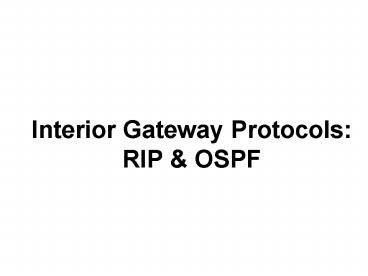Interior Gateway Protocols: RIP - PowerPoint PPT Presentation
1 / 23
Title:
Interior Gateway Protocols: RIP
Description:
Routing table used by IP forwarding. Can display routing table using command 'netstat -rn' ... Hysteresis: Equal cost routes doesn't replaced. 13 ... – PowerPoint PPT presentation
Number of Views:181
Avg rating:3.0/5.0
Title: Interior Gateway Protocols: RIP
1
Interior Gateway Protocols RIP OSPF
2
Overview
- Routing Tables static routing
- Dynamic routing (inter- and intra-domain)
- Distance vector vs Link state routing
- RIP, RIPv2
- OSPF
3
Routing vs Forwarding
- Routing table used by IP forwarding. Can display
routing table using command netstat -rn - Route Table setup by
- a) route command
- b) routing daemon (eg routed)
- c) ICMP redirect message.
4
Routing Table structure
- Fields destination, gateway, flags
- Destination can be a host address or a network
address. If the H flag is set, it is the host
address. - Gateway router/next hop IP address. The G flag
says whether the destination is directly or
indirectly connected. - U flag Is route up ?
- G flag router (indirect vs direct)
- H flag host (dest field host or n/w address?)
5
Static Routing
- Upon booting, default routes initialized from
files. Eg /etc/rc.net in AIX, /etc/netstart in
BSD, /etc/rc.local in SUN/Solaris - Use route command to add new routes eg route
add default sun 1
6
Dynamic routing
- Internet organized as autonomous systems (AS).
- Interior Gateway Protocols (IGPs) within AS. Eg
RIP, OSPF, HELLO - Exterior Gateway Protocols (EGPs) for AS to AS
routing. Eg EGP, BGP-4
7
Dynamic routing methods
- Link state routing Get map of network (in terms
of link states) and calculate best route (but
specify only a signpost I.e. the next-hop) - Distance vector
8
Distance Vector routing
- How to find distances ?
- Look in neighbors distance vectors, and add link
cost to reach the neighbor - Find which direction yields minimum distance to
to particular destination. Turn signpost that
way. - Keep checking if neighbors change their signposts
and modify local vector if necessary. - Called the Bellman-Ford algorithm
9
Distance Vector routing
10
Distance Vector routing
11
Distance Vector routing
12
Routing Information Protocol (RIP)
- Active / Passive participant
- Use Hop count matric
- To simulate slow link, manager can add high hop
counts. - Tables (vectors) advertised to neighbors every
30 s. - To improve performance and efficiency
- Hysteresis Equal cost routes doesnt replaced
13
- Robustness Entries invalid if no refresh for 180
s. - Protocol details
- Runs over UDP.
- Init send request message asking for vectors
- Format can carry upto 25 routes (within 512
bytes) - RIPv1 does not carry subnet masks gt many
networks use default of 255.255.255.0
14
RIP problems
- Counting-to-infinity problem
- Slow convergence after topology change
- Due to count to infinity problem
- Also information cannot propagate thru node until
it recalculates routing info.
15
RIP Problems Solution
- Split-horizon
- ? Router does not propagate information back
over the same interface from which route arrives - ? No routing loops
- Hold Down Timer
- ?once bad news received wait 60 sec.
- Triggered updates used to inform neighbors when
table changes.
16
RIP problems (contd)
- Broadcasts consume non-router resources
- Does not support subnet masks (VLSMs)
- No authentication
17
RIPv2
- Why ? Installed base of RIP routers
- Provides
- VLSM support
- Authentication
- Multicasting
- Wire-sharing by multiple routing domains,
- Tags to support EGP/BGP routes.
- Uses reserved fields in RIPv1 header.
- First route entry replaced by authentication
info.
18
Link State protocols
- Create a network map at each node.
- For a map, we need links and attributes (link
states), not of destinations and metrics
(distance vector) - 1. Node collects the state of its connected links
and forms a Link State Packet (LSP) - 2. Broadcast LSP gt reaches every other node in
the network. - 3. Given map, run Dijkstras shortest path
algorithm gt get paths to all destinations - 4. Routing table next hops of these paths.
19
Dijkstras algorithm
- A.k.a Shortest Path First (SPF) algorithm.
- Idea compute shortest path from a root node to
every other node.Greedy method - P is a set of nodes for which shortest path has
already been found. - For every node o outside P, find shortest
one-hop path from some node in P. - Add that node o which has the shortest of these
paths to P. Record the path found. - Continue till we add all nodes (paths) to P
20
Topology dissemination
- 1. Sequence numbers to detect duplicates
- Why? Routers/links may go down/up
- Problem wrap-around gt have large seq space
- 2. Age field (similar to TTL)
- Periodically decremented after acceptance
- Zero gt discard LSP request everyone to do so
- Router awakens gt knows that all its old LSPs
would have been purged and can choose a new
initial sequence number
21
Link state vs Distance vector
- Advantages
- More stable (asa fewer routing loops)
- Faster convergence than distance vector
- Easier to discover network topology,
troubleshoot network. - Can do better source-routing with link-state
- Type Quality-of-service routing (multiple
route tables) possible - Caveat With path-vector-type distance vector
routing, these arguments dont hold
22
OSPF
- OSPF runs directly on top of IP (not over UDP)
- It can calculate a separate set of routes for
each IP type of service (gt multiple routing
entries) - Dimensionless cost (eg based on throughput,
delay) - Load balancing distributing traffic equally
among routes - Supports VLSMs subnet mask field in header
- Supports multicasting, authentication, unnumbered
networks (point-to-point).
23
Summary
- Route Tables
- Distance vector, RIP, RIPv2
- Link state, OSPF.































